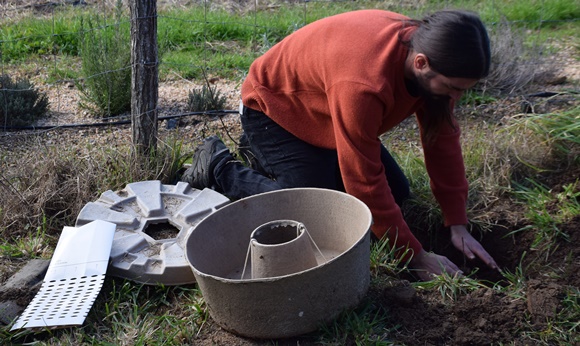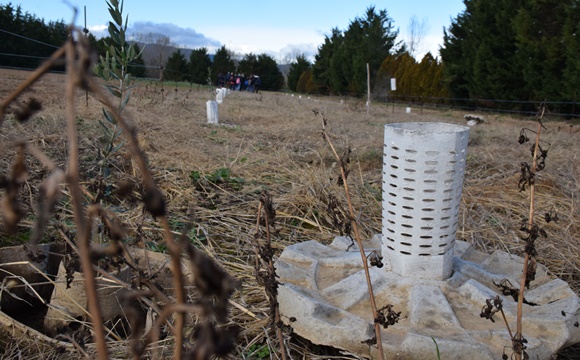The Cocoon system improves success rates when reforesting degraded land
Around 30,000 trees and shrubs were planted between 2016 and 2019 in the Mediterranean basin and the Canary Islands, with a survival rate achieved that varied between 20 and 80%, depending on the species involved. The economic analysis shows that the Cocoon system can be up to four times more profitable than the normal reforestation method.
CREAF and an international team of experts are showing that reforestation is more successful with the Cocoon system. Cocoons are biodegradable doughnut-shaped cardboard pots for restoring degraded land. Placed in the ground and filled with water, they hydrate and protect seedlings for the first year of their life, when they are at their most vulnerable, before decomposing in the soil. Developed by the Dutch firm Land Life Company, the system has been used by CREAF and its partners in a European LIFE project called The Green Link, the final results of which were presented at the Institute for Catalan Studies today. The project involved using this innovative technology to plant approximately 30,000 trees and shrubs between 2016 and 2019 in different parts of the Mediterranean region, including Catalonia, Valencia, Almeria, Italy and Greece, and in the Canary Islands. The trees and shrubs were planted on recovering sites, such as former mines and fire-damaged, marginal or abandoned land. The Cocoon system proved more effective than usual planting methods, particularly on arid and semi-arid land.

The project’s results were encouraging, leading the experts to conclude that Cocoons could help reforest degraded land in the current environmental crisis. “Adapting to climate change means doing this, developing and testing new technologies that could help restore degraded land, bearing in mind that extreme episodes are set to become increasingly harsh and frequent”, says CREAF researcher Vicenç Carabassa, the project’s coordinator.
According to a very positive economic study of the technology carried out by Land Life Company and VOLTERRA, the Cocoon system can be up to four times more profitable than the normal reforestation method, based on cost-ratio benefits. Furthermore, its use extends the window for planting trees, which can be brought forward to September or even August and delayed until late spring or early summer.
All the project’s reforestation activities involved local stakeholders, i.e. private companies, administrative bodies, farmers, livestock breeders, forest owners and NGOs. A total of seven pilot tests were undertaken to compare reforestation using the Cocoon system with usual reforestation methods. Additionally, 7,500 Cocoons were distributed to replicate the tests in different situations and circumstances, so as to obtain more data and impressions.
An all-terrain pot
One of the most problematic planting sites was Tifaracás in Gran Canaria. Tifaracás is among the driest parts of the island biosphere reserve, with annual rainfall averaging under 200 mm and dipping further below that figure in recent years. Reforestation work performed in Gran Canaria before the Cocoon system was tested was hugely expensive, as complex irrigation systems were required to keep the planted trees’ death rate from reaching 100%. “It’s an extremely arid environment with very steep slopes, exceptionally poor, stony soil, and a tremendous problem with goats eating seedlings, making it uniquely difficult to repopulate”, explains Carabassa. The survival rate achieved with the Cocoon system varied between 20 and 80%, depending on the species involved. This pilot test was supported by Gran Canaria Island Council and GESPLAN.

The Cocoon system has made it possible to reforest burned areas such as El Bruc in Catalonia, which was affected by a fire in 2015. Around 4,000 trees were planted in El Bruc, a combination of forest species, such as common, holm and holly oaks, and agricultural species, including olive, walnut, cherry and fig trees. Rather than restoring the Aleppo pine forest that burned down, the aim is to reforest the fire-damaged area with an agroforestry mosaic that will have greater biodiversity and be much more resistant to fires. The results of the Cocoon system pilot test were very positive, with 60% of the trees surviving, twice as many as with usual methods. Here too, the level of success varied from species to species. VOLTERRA planted 2,000 specimens of three varieties of olive tree, specifically Arbequina, Vera and Cornicabra trees. The best results were obtained with Cornicabra trees, 77% of which have so far survived thanks to the Cocoon system.
Encouraging results
In Valencia, testing was carried out on a site damaged by fire in 2012 close to Tous (Ribera Alta), which, left to its own devices, was turning into scrubland rather than recovering as woodland, as well as on an abandoned area in the town of Xixona (Alacantí). In the latter case, the trees planted were mainly agricultural species but included some forest species, such as the strawberry tree, which has done surprisingly well, with certain specimens growing spectacularly. The work undertaken in Valencia was another resounding success, with the survival rate of the seedlings planted in Cocoons presently being 85% higher than that of those planted using usual reforestation methods. It was performed in conjunction with the Desertification Research Centre (CIDE-CSIC), which is linked to the University of Valencia.
The pilot test conducted in Almeria was chiefly aimed at promoting local traditional agricultural activity through organic almond farming. To that end, 2,000 specimens of different varieties of almond trees were planted on a barren, waterless, abandoned site. The work in question took place in cooperation with AlVelAl and the University of Almeria.
The project also encompassed planting trees in Portugal, Italy (in Calabria) and in Greece (in Ptolemais), where CREAF worked with the Centre for Research and Technology-Hellas (CERTH) to reforest an opencast coal mine.







